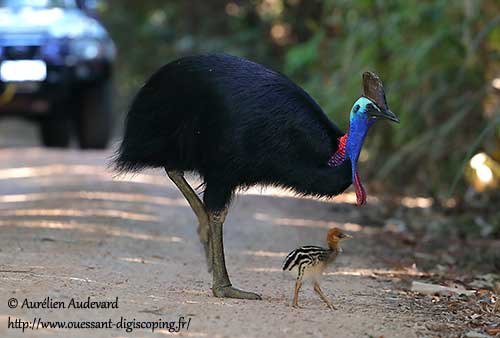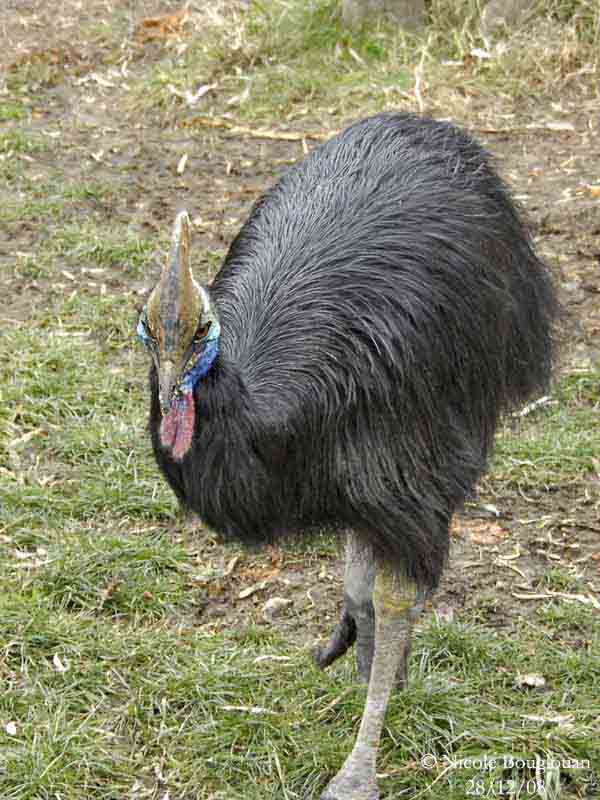
Southern Cassowary
Casuarius casuarius
Casuariiformes Order – Casuariidae Family
BIOMETRICS:
Height: 130-170 cm
Weight: male: 29-34 kg – F: 58 kg
DESCRIPTION:
Southern Cassowary is the second largest and tallest bird after the Ostrich. This species differs in general facts by the female. She has the criterions of most of the other species’ males, such as brighter colours, really much larger size, and she does not share the nesting duties with the male.

Adult male has glossy black plumage overall. This plumage is very hard and coarse, and allows the bird to live in inhospitable habitats.
The tail lacks rectrices, and the wings are small, even smaller than in other large terrestrial birds. These particular wings show only bare quills, curving round on flanks, probably for protecting the body against the thorny and dense vegetation.
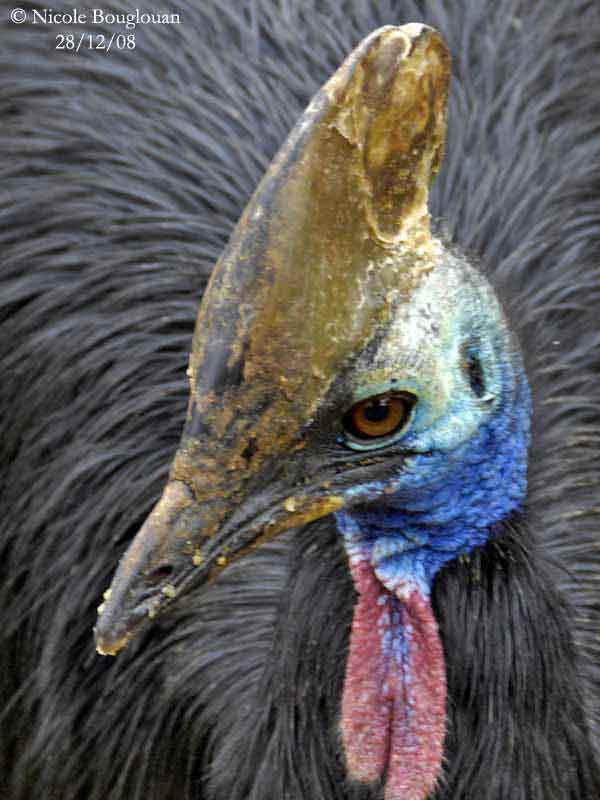
On the head, the bare skin is pale blue on the upper head to brighter blue on cheeks and head sides. The nape and the rear neck are covered with bare red skin. Two red wattles hang from the chin, and their length may vary.
On head-top, we can see a casque. It is horn-coloured and shorter than in female.
The strong bill is relatively short and slightly decurved. The eyes are brown with pale blue eye-ring.
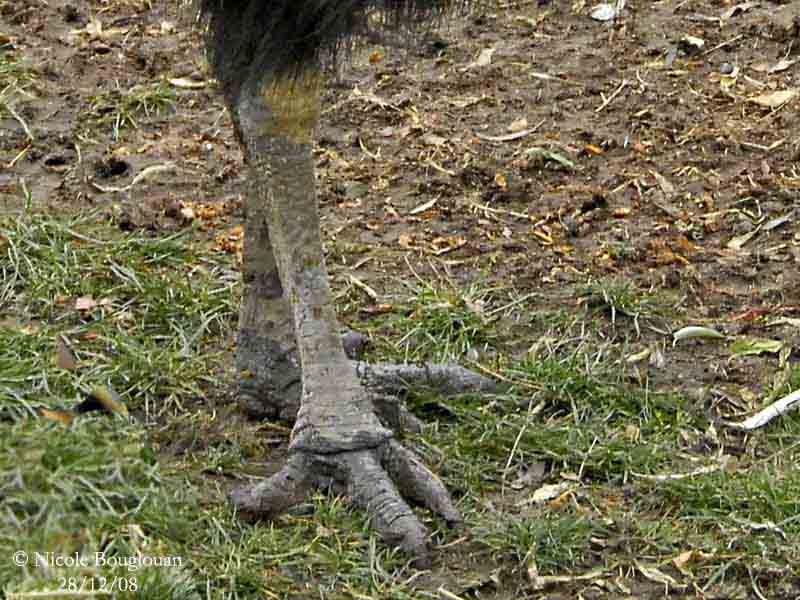
The strong bare legs and feet are very powerful. There are three robust toes, equipped with stout claws. The inner toe is armed with a long, dagger-shaped claw of several centimetres long. Legs and feet are grey.
Female has similar appearance, but she is larger, and she has brighter colours and larger casque than male.
In both sexes, the wattles’ colour may change according to the mood.
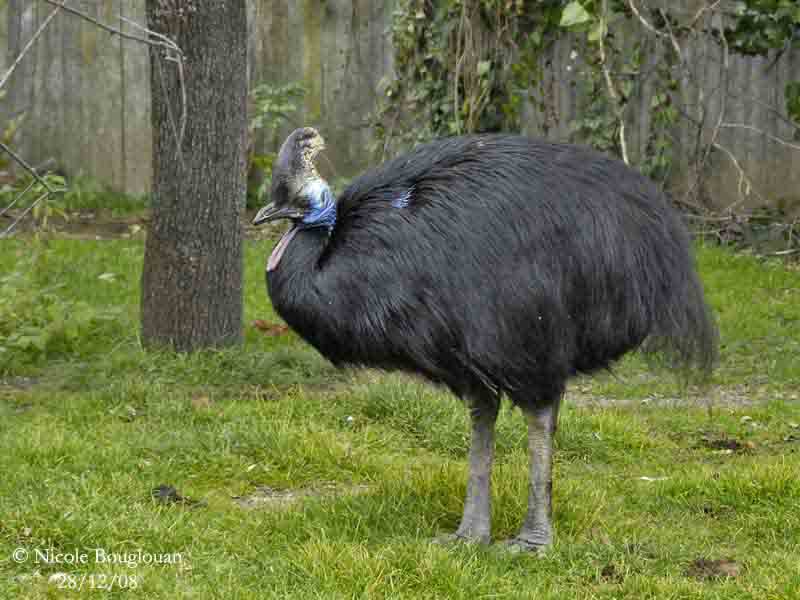
Juvenile is pale brown. The bare parts are duller and the casque very small, growing little by little. Wattles are yellowish-brown and the eyes are dark brown.
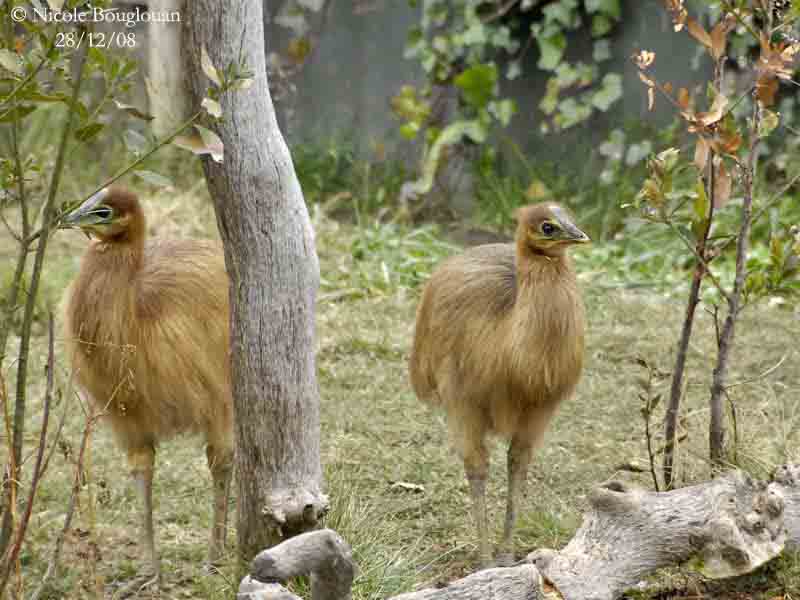
VOICE: SOUNDS BY XENO-CANTO
Southern Cassowary utters varied sounds according to the moment. Usually, this bird is silent outside the breeding season.
The alarm call is a rumbling sound. They also give hisses, whistles and low growls. They perform bill-clapping in threat behaviour, and utter loud roars when fighting.
Before the copulation, male gives some “boo-boo-boo”, becoming rarer towards the end of the breeding season. Some contact calls are uttered between male and young.
HABITAT:
Southern Cassowary frequents mainly the rainforest. This species prefers virgin forests where it can live free from disturbances.
It is often found at medium elevation, in dense tropical rainforest, but also in galleries and swamp forests.
RANGE:
Southern Cassowary lives in Aru and Seram Islands of Indonesia, in New Guinea and NE Australia.
BEHAVIOUR:
Southern Cassowary feeds mainly on fallen fruits on the forest floor. It may sometimes pluck them from low branches or bushes.
This species needs a wide diversity of fruiting-plants all year round. It may eat fruits of about 75 different plant species. It needs a large quantity of food and may raid gardens and orchards when food resources are scarce.
Southern Cassowary forages alone, walking slowly along usual tracks. It picks up the food with the bill and tosses it up directly into the throat. The fruit is swallowed whole. The droppings are full of seeds which regularly regenerate the vegetation of the habitat.
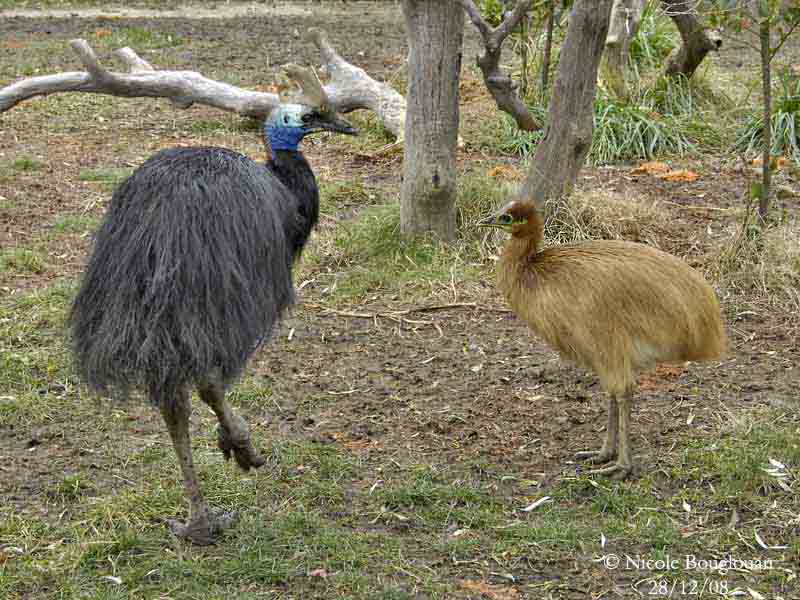
This bird is very shy and difficult to observe. Usually, it disappears into the dense forest as soon as an intruder approaches.
It is a solitary bird outside the breeding season. It defends its territory all year round. It is sedentary but performs some nomadic movements.
It rests in the middle of the day, and forages mainly in the morning and the late afternoon.
During the breeding season, the Southern Cassowary becomes aggressive, mainly when chicks are present. Before to attack, the bird performs a threat display, arching the body upwards and fluffing the rump feathers. Then, it bends the neck with bill pointed downwards while it utters a deep booming sound with shaking body.
The initial posture is also used in courtship displays. The female is dominant and the male runs away if the larger female performs threat displays.
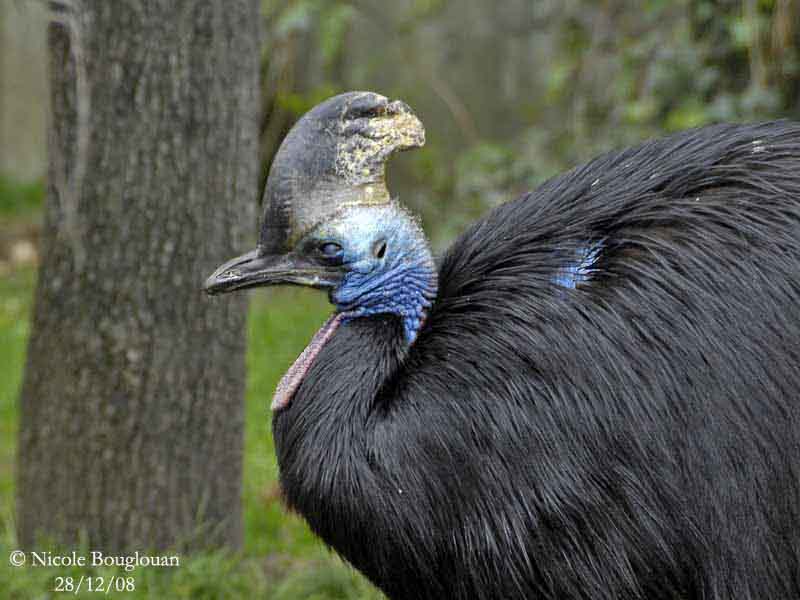
In case of fight, the inner toe’s long claw is a very dangerous weapon, causing mortal injuries to dogs or humans. But open aggressions are not usual and generally, only the threat displays are observed.
MOVEMENTS:
Southern Cassowary does not fly. Its powerful legs and feet allow it to run at speeds of up to 50 km per hour. It is able to jump up to 5 metres. It also can swim, and cross lakes and wide rivers without any difficulty.
REPRODUCTION:
Breeding season starts at the end of the dry season in New Guinea, and from June to October in Queensland.
The female copulates with several males, and disappears as soon as the eggs are laid.
The nest is a shallow depression scraped in the ground, with a lining of leaves and grasses. It is very well camouflaged in the vegetation.
She lays 3 to 5 greenish eggs. Incubation by the male lasts about 50 days. The male rears the chicks during about 9 months.
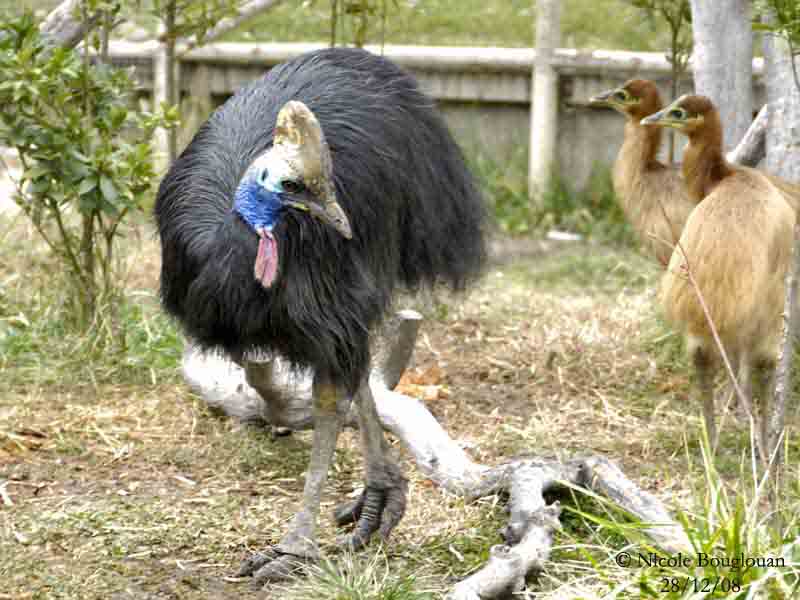
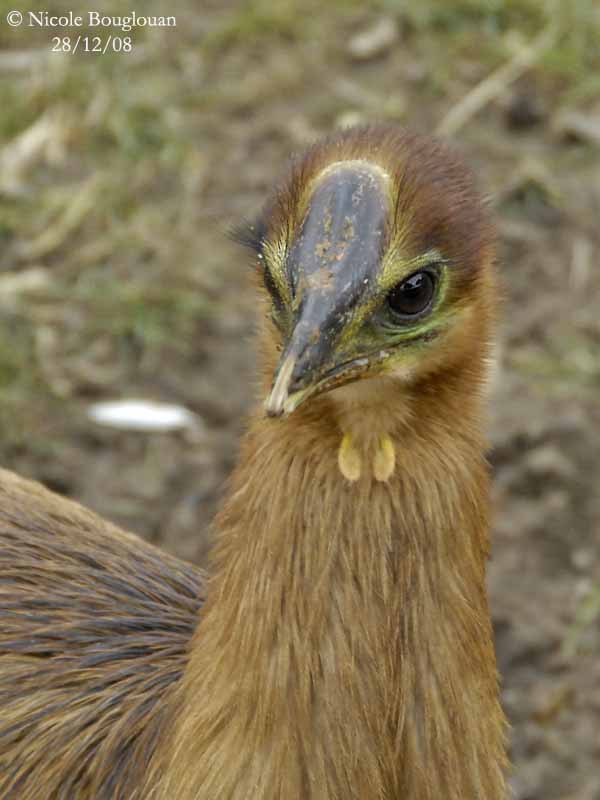
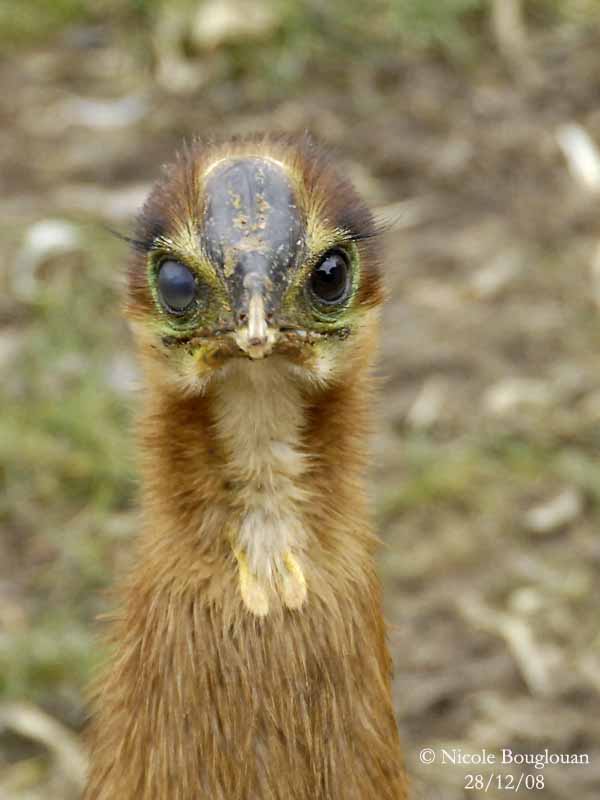
DIET:
Southern Cassowary feeds mainly on fallen fruits of different plant’s species. It also consumes invertebrates, small vertebrates and sometimes carrion.
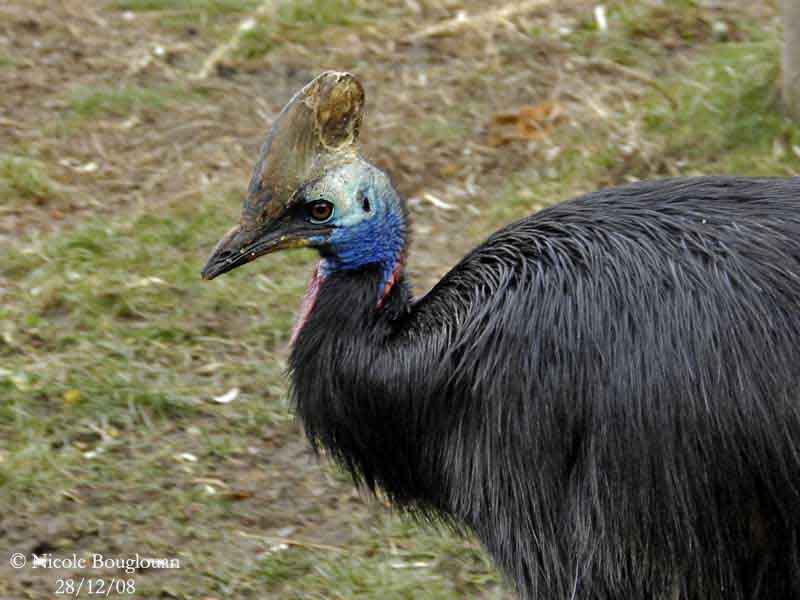
PROTECTION / THREATS / STATUS:
Southern Cassowary is fairly widespread in New Guinea, but declines due to habitat loss and hunting occurred. Disturbances are also an important fact in local declines.
Fr: Casoar à casque
All : Helmkasuar
Esp : Casuario Común
Ital: Casuario australiano
Nd: Helmcasuarius
Russe: шлемоносный казуар
Photographers:
Aurélien Audevard
OUESSANT DIGISCOPING
Other photographs and text by Nicole Bouglouan
Pictures taken at the Zoo-Aquarium of Madrid
Sources :
HANDBOOK OF THE BIRDS OF THE WORLD vol 1 by Josep del Hoyo-Andrew Elliot-Jordi Sargatal - Lynx Edicions - ISBN: 8487334105
L’ENCYCLOPEDIE MONDIALE DES OISEAUX - Dr Christopher M. Perrins - BORDAS - ISBN: 2040185607
Birds in backyards (Birds Australia and Australian Museum)
El Zoológico Electrónico (Damisela)
